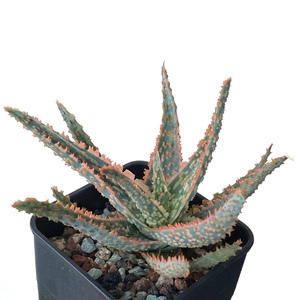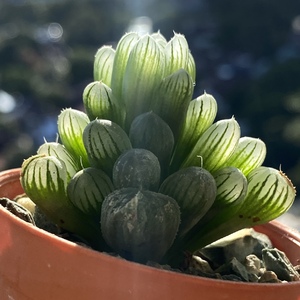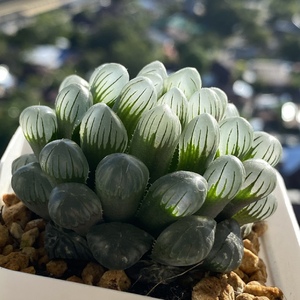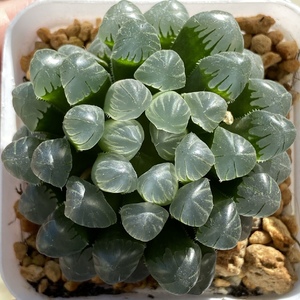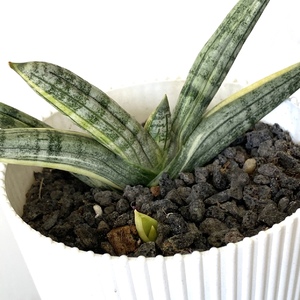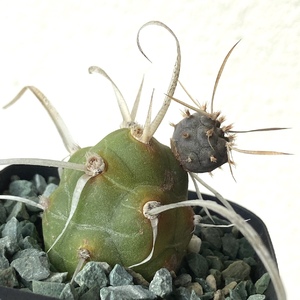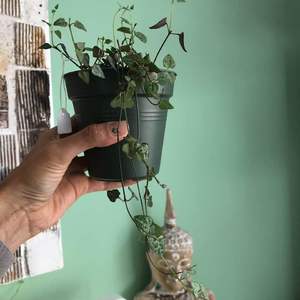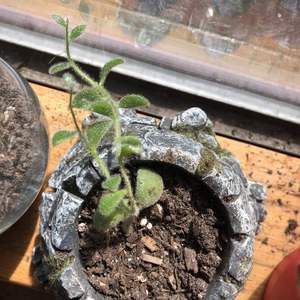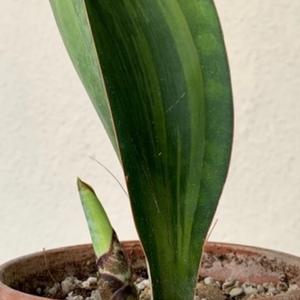文章
ritau
2020年03月26日

Lilies are genus of herbaceous flowering plants growing from bulbs, all with large prominent flowers. Lilies are a group of flowering plants which are important in culture and literature in much of the world. Most species are native to the temperate northern hemisphere, though their range extends into the northern subtropics. Many other plants have "lily" in their common name but are not related to true lilies.

Lilies are tall perennials ranging in height from 2–6 ft (60–180 cm). They form naked or tunicless scaly underground bulbs which are their organs of perennation. In some North American species the base of the bulb develops into rhizomes, on which numerous small bulbs are found. Some species develop stolons. Most bulbs are buried deep in the ground, but a few species form bulbs near the soil surface. Many species form stem-roots. With these, the bulb grows naturally at some depth in the soil, and each year the new stem puts out adventitious roots above the bulb as it emerges from the soil. These roots are in addition to the basal roots that develop at the base of the bulb.
The flowers are large, often fragrant, and come in a wide range of colors including whites, yellows, oranges, pinks, reds and purples. Markings include spots and brush strokes. The plants are late spring- or summer-flowering. Flowers are borne in racemes or umbels at the tip of the stem, with six tepals spreading or reflexed, to give flowers varying from funnel shape to a "Turk's cap". The tepals are free from each other, and bear a nectary at the base of each flower. The ovary is 'superior', borne above the point of attachment of the anthers. The fruit is a three-celled capsule.

Many species are widely grown in the garden in temperate and sub-tropical regions. They may also be grown as potted plants. Numerous ornamental hybrids have been developed. They can be used in herbaceous borders, woodland and shrub plantings, and as patio plants. Some lilies, especially Lilium longiflorum, form important cut flower crops. These may be forced for particular markets; for instance, Lilium longiflorum for the Easter trade, when it may be called the Easter lily.
Lilies are usually planted as bulbs in the dormant season. They are best planted in a south-facing (northern hemisphere), slightly sloping aspect, in sun or part shade, at a depth 2½ times the height of the bulb (except Lilium candidum which should be planted at the surface). Most prefer a porous, loamy soil, and good drainage is essential. Most species bloom in July or August (northern hemisphere). The flowering periods of certain lily species begin in late spring, while others bloom in late summer or early autumn.They have contractile roots which pull the plant down to the correct depth, therefore it is better to plant them too shallowly than too deep. A soil pH of around 6.5 is generally safe. The soil should be well-drained, and plants must be kept watered during the growing season. Some plants have strong wiry stems, but those with heavy flower heads may need staking.


Lilies are tall perennials ranging in height from 2–6 ft (60–180 cm). They form naked or tunicless scaly underground bulbs which are their organs of perennation. In some North American species the base of the bulb develops into rhizomes, on which numerous small bulbs are found. Some species develop stolons. Most bulbs are buried deep in the ground, but a few species form bulbs near the soil surface. Many species form stem-roots. With these, the bulb grows naturally at some depth in the soil, and each year the new stem puts out adventitious roots above the bulb as it emerges from the soil. These roots are in addition to the basal roots that develop at the base of the bulb.
The flowers are large, often fragrant, and come in a wide range of colors including whites, yellows, oranges, pinks, reds and purples. Markings include spots and brush strokes. The plants are late spring- or summer-flowering. Flowers are borne in racemes or umbels at the tip of the stem, with six tepals spreading or reflexed, to give flowers varying from funnel shape to a "Turk's cap". The tepals are free from each other, and bear a nectary at the base of each flower. The ovary is 'superior', borne above the point of attachment of the anthers. The fruit is a three-celled capsule.

Many species are widely grown in the garden in temperate and sub-tropical regions. They may also be grown as potted plants. Numerous ornamental hybrids have been developed. They can be used in herbaceous borders, woodland and shrub plantings, and as patio plants. Some lilies, especially Lilium longiflorum, form important cut flower crops. These may be forced for particular markets; for instance, Lilium longiflorum for the Easter trade, when it may be called the Easter lily.
Lilies are usually planted as bulbs in the dormant season. They are best planted in a south-facing (northern hemisphere), slightly sloping aspect, in sun or part shade, at a depth 2½ times the height of the bulb (except Lilium candidum which should be planted at the surface). Most prefer a porous, loamy soil, and good drainage is essential. Most species bloom in July or August (northern hemisphere). The flowering periods of certain lily species begin in late spring, while others bloom in late summer or early autumn.They have contractile roots which pull the plant down to the correct depth, therefore it is better to plant them too shallowly than too deep. A soil pH of around 6.5 is generally safe. The soil should be well-drained, and plants must be kept watered during the growing season. Some plants have strong wiry stems, but those with heavy flower heads may need staking.

0
0
文章
ritau
2020年02月18日

Hydroponics is a subset of hydroculture, which is a method of growing plants without soil, by instead using mineral nutrient solutions in a water solvent.Terrestrial plants may be grown with only their roots exposed to the nutritious liquid, or the roots may be physically supported by an inert medium such as perlite, gravel.Despite inert media, roots can cause changes of the rhizosphere pH and root exudates can impact the rhizosphere biology.
The nutrients used in hydroponic systems can come from an array of different sources, including (but not limited to) fish excrement, duck manure, purchased chemical fertilisers, or artificial nutrient solutions.
Plants commonly grown hydroponically on inert media include tomatoes, peppers, cucumbers, lettuces, marijuana, and model plants like Arabidopsis thaliana.
Hydroponics offer many advantages, one of them being a decrease in water usage for agriculture. To grow 1 kilogram of tomatoes in Intensive farming requires 400 liters of water, in hydroponics 70 liters of water, and only 20 liters of water for aeroponics.Because of the lack of water needed to grow produce, it would be possible in the future for harsh environments which don’t have much accessible water, to be able to grow their own food.
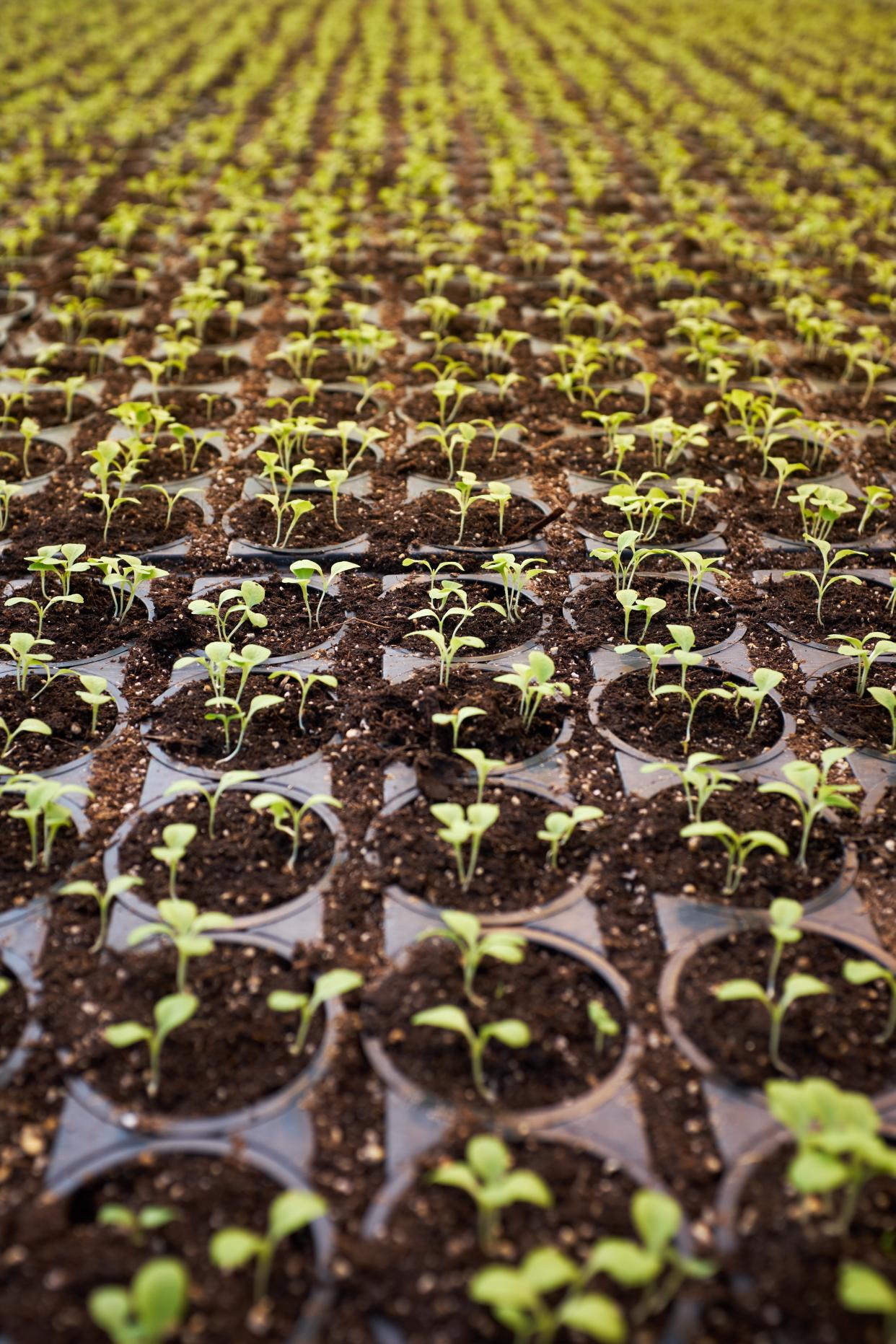
The earliest published work on growing terrestrial plants without soil was the 1627 book Sylva Sylvarum or 'A Natural History' by Francis Bacon, printed a year after his death. Water culture became a popular research technique after that. In 1699, John Woodward published his water culture experiments with spearmint. He found that plants in less-pure water sources grew better than plants in distilled water. By 1842, a list of nine elements believed to be essential for plant growth had been compiled, and the discoveries of German botanists Julius von Sachs and Wilhelm Knop, in the years 1859-1875, resulted in a development of the technique of soilless cultivation.Growth of terrestrial plants without soil in mineral nutrient solutions was called solution culture. It quickly became a standard research and teaching technique and is still widely used. Solution culture is, now considered, a type of hydroponics where there is an inert medium.

The nutrients used in hydroponic systems can come from an array of different sources, including (but not limited to) fish excrement, duck manure, purchased chemical fertilisers, or artificial nutrient solutions.
Plants commonly grown hydroponically on inert media include tomatoes, peppers, cucumbers, lettuces, marijuana, and model plants like Arabidopsis thaliana.
Hydroponics offer many advantages, one of them being a decrease in water usage for agriculture. To grow 1 kilogram of tomatoes in Intensive farming requires 400 liters of water, in hydroponics 70 liters of water, and only 20 liters of water for aeroponics.Because of the lack of water needed to grow produce, it would be possible in the future for harsh environments which don’t have much accessible water, to be able to grow their own food.

The earliest published work on growing terrestrial plants without soil was the 1627 book Sylva Sylvarum or 'A Natural History' by Francis Bacon, printed a year after his death. Water culture became a popular research technique after that. In 1699, John Woodward published his water culture experiments with spearmint. He found that plants in less-pure water sources grew better than plants in distilled water. By 1842, a list of nine elements believed to be essential for plant growth had been compiled, and the discoveries of German botanists Julius von Sachs and Wilhelm Knop, in the years 1859-1875, resulted in a development of the technique of soilless cultivation.Growth of terrestrial plants without soil in mineral nutrient solutions was called solution culture. It quickly became a standard research and teaching technique and is still widely used. Solution culture is, now considered, a type of hydroponics where there is an inert medium.

0
0
文章
ritau
2020年01月17日

Hi everybody, today I'm going to introduce 6 ideas for balcony gardening, come and try!
1. Sunny Side
This balcony garden is sunny and bright! Citrus trees love the sun, making a sunny balcony the ideal location for growing your own fruit. This creative balcony garden proves you do not need matching pots to be a stunning area. The plants are offered protection from the sun by the white umbrella secured to the balcony railing. From the collection of play toys to the red and white striped fabric shade, this is also a space to share with a child. The addition of the hanging light over the café table allows this balcony to be used even at night!

2. Tiny Park
Is a tiny yard and garden on your balcony possible? When creating a balcony garden design you can have both! Using AstroTurf on your balcony floor, you are able to create a yard in the city or on your apartment balcony. Colorful, yet edible kale is showcased in wooden crates. Hanging garden boxes provide additional growing space on the balcony railing in this design. With the predominantly green landscape, the pop of fuchsia color from the flower is a nice addition. Even the tiny herbs have a home in the small terra cotta pots lining the side of this balcony!

3. Modern Comfort
Modern meets comfort in this beautiful balcony garden decor. Elements of home design have been carried through to this balcony. When combining home design with the outdoors, it’s important to bring home décor to the space. With the pillow, blanket, and serving tray this balcony garden has done just that! Aside from the wicker chair, this space doesn’t feature typical outdoor furniture. A stool is used as a plant display and a rope covered ottoman keeps the home décor feel alive. Keeping with the theme, the rug breaks up the modern gray on this balcony adding yet another visual element of comfort.

4. The Secret Garden
Sometimes you need a retreat you can escape to. This serene balcony garden is reminiscent of a secret Victorian garden with the ivy growing along the stone wall. Including a stone angel statue further confirms the feel. Growing trees in pots is a great way to add vertical elements. This design also incorporates stacking pots for added height. In this balcony garden design, rosemary is in bloom creating a delightful smell as well as adding a touch of purple color. The modest café table ensures a nice place to sit for coffee, tea, or simply a place to rest.

5. Italian Flair
Inspired by an Italian window garden, this colorful balcony proves you can make a dramatic impact in a small space. Although there isn’t enough room for a table or chairs, this beautiful display of showy petunias is a showstopper. Window boxes are hung on the outside of the balcony where they can easily be seen from below. This design incorporates smaller pots on the inside of the balcony floor to grow greenery. By adding the greenery, a nice backdrop is provided for the petunias creating a seamless flow. Even the wall behind the balcony was used to display the beautiful flowers.

Source:HOMEBNC
1. Sunny Side
This balcony garden is sunny and bright! Citrus trees love the sun, making a sunny balcony the ideal location for growing your own fruit. This creative balcony garden proves you do not need matching pots to be a stunning area. The plants are offered protection from the sun by the white umbrella secured to the balcony railing. From the collection of play toys to the red and white striped fabric shade, this is also a space to share with a child. The addition of the hanging light over the café table allows this balcony to be used even at night!

2. Tiny Park
Is a tiny yard and garden on your balcony possible? When creating a balcony garden design you can have both! Using AstroTurf on your balcony floor, you are able to create a yard in the city or on your apartment balcony. Colorful, yet edible kale is showcased in wooden crates. Hanging garden boxes provide additional growing space on the balcony railing in this design. With the predominantly green landscape, the pop of fuchsia color from the flower is a nice addition. Even the tiny herbs have a home in the small terra cotta pots lining the side of this balcony!

3. Modern Comfort
Modern meets comfort in this beautiful balcony garden decor. Elements of home design have been carried through to this balcony. When combining home design with the outdoors, it’s important to bring home décor to the space. With the pillow, blanket, and serving tray this balcony garden has done just that! Aside from the wicker chair, this space doesn’t feature typical outdoor furniture. A stool is used as a plant display and a rope covered ottoman keeps the home décor feel alive. Keeping with the theme, the rug breaks up the modern gray on this balcony adding yet another visual element of comfort.

4. The Secret Garden
Sometimes you need a retreat you can escape to. This serene balcony garden is reminiscent of a secret Victorian garden with the ivy growing along the stone wall. Including a stone angel statue further confirms the feel. Growing trees in pots is a great way to add vertical elements. This design also incorporates stacking pots for added height. In this balcony garden design, rosemary is in bloom creating a delightful smell as well as adding a touch of purple color. The modest café table ensures a nice place to sit for coffee, tea, or simply a place to rest.

5. Italian Flair
Inspired by an Italian window garden, this colorful balcony proves you can make a dramatic impact in a small space. Although there isn’t enough room for a table or chairs, this beautiful display of showy petunias is a showstopper. Window boxes are hung on the outside of the balcony where they can easily be seen from below. This design incorporates smaller pots on the inside of the balcony floor to grow greenery. By adding the greenery, a nice backdrop is provided for the petunias creating a seamless flow. Even the wall behind the balcony was used to display the beautiful flowers.

Source:HOMEBNC
0
0
文章
ritau
2020年01月09日

"In case I don't see ya', good afternoon, good evening and goodnight."
Hi, everybody, today we are going to introduce a common plant---Mint, about how to grow it at home and how to drink it!

Growing Mint
*plant
a. white thick rhizome should be chosen
b. trim it to about 8cm long and bury it
*Soil
loose & sand soil
well drained
fertile
*Temperature
20-30C°
Proper light
tends to be wetter
When it's time to harvest, let's pick up a couple of leaves and make a Mojito!

Recipe:
*Material
a. white rum-45ml
b. lemon-quarter
c. sugar-2 spoons
d. soda water-150ml
e. crushed ice-a few
*Steps:
a. clean the mint leaves, mash the leaves with sugar and put them all into a glass
b. squeeze the lemon juice into the glass, and also put lemon into it
c. put ice into the class
d. pour the rum and soda water into the glass
Hi, everybody, today we are going to introduce a common plant---Mint, about how to grow it at home and how to drink it!

Growing Mint
*plant
a. white thick rhizome should be chosen
b. trim it to about 8cm long and bury it
*Soil
loose & sand soil
well drained
fertile
*Temperature
20-30C°
Proper light
tends to be wetter
When it's time to harvest, let's pick up a couple of leaves and make a Mojito!

Recipe:
*Material
a. white rum-45ml
b. lemon-quarter
c. sugar-2 spoons
d. soda water-150ml
e. crushed ice-a few
*Steps:
a. clean the mint leaves, mash the leaves with sugar and put them all into a glass
b. squeeze the lemon juice into the glass, and also put lemon into it
c. put ice into the class
d. pour the rum and soda water into the glass
0
0
文章
ritau
2020年01月08日

Potatoes are an indispensable food on our dining-table. We often buy potatoes in the markets, but do you ever think growing potatoes at home! Here are some ways for you:
1. Using Wood boxes
Build or buy a bottomless square box. After the box is designed you can add additional slats and soil as the plants grow. In theory, you can temporarily remove the bottom slat for harvesting, or just tip it over. This is another strategy for growing potatoes where the ground soil is of poor quality. It yielded a similar quantity to the raised bed.

2. Using Bags
Put a few inches of a soil-compost mixture in the bottom of a bag, then plant three or four seed potato pieces and cover with 3 inches of soil. Continue adding soil as the plants grow until the bag is full. To harvest, turn the bag on its side and dump out the contents.
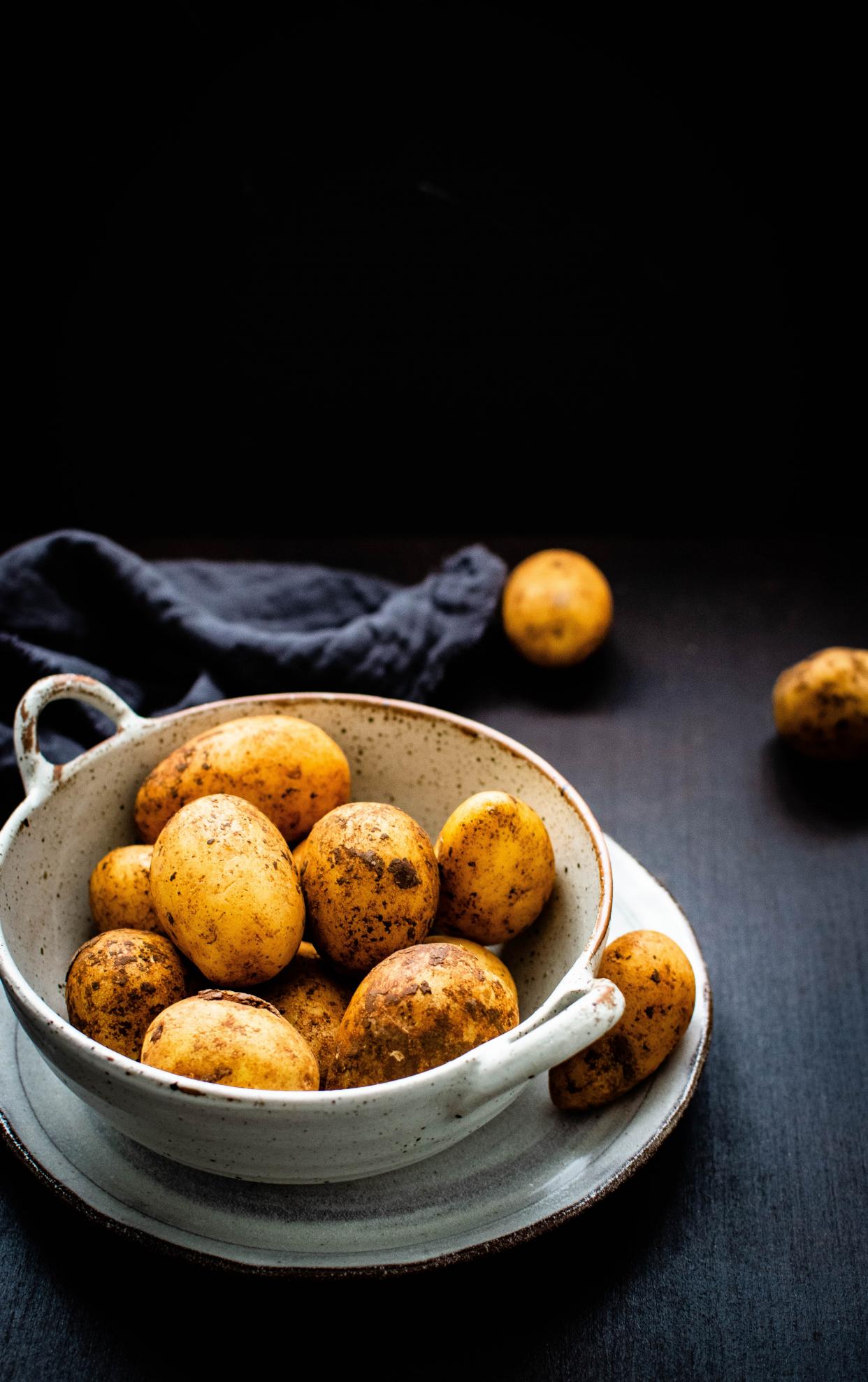
3. Using Straw Mulch
Place seed potatoes on the surface of prepared soil following the spacing specified for hilled rows and cover them with 3 to 4 inches of loose, seed-free straw. Mound more straw around the stems as they grow, eventually creating a layer of one foot or more in depth.
1. Using Wood boxes
Build or buy a bottomless square box. After the box is designed you can add additional slats and soil as the plants grow. In theory, you can temporarily remove the bottom slat for harvesting, or just tip it over. This is another strategy for growing potatoes where the ground soil is of poor quality. It yielded a similar quantity to the raised bed.

2. Using Bags
Put a few inches of a soil-compost mixture in the bottom of a bag, then plant three or four seed potato pieces and cover with 3 inches of soil. Continue adding soil as the plants grow until the bag is full. To harvest, turn the bag on its side and dump out the contents.

3. Using Straw Mulch
Place seed potatoes on the surface of prepared soil following the spacing specified for hilled rows and cover them with 3 to 4 inches of loose, seed-free straw. Mound more straw around the stems as they grow, eventually creating a layer of one foot or more in depth.
0
0
文章
A🎌王木木💮
2019年11月25日

Today we are going to introduce the third kind of flower that is suitable for growing in winter.That is cyclamen.
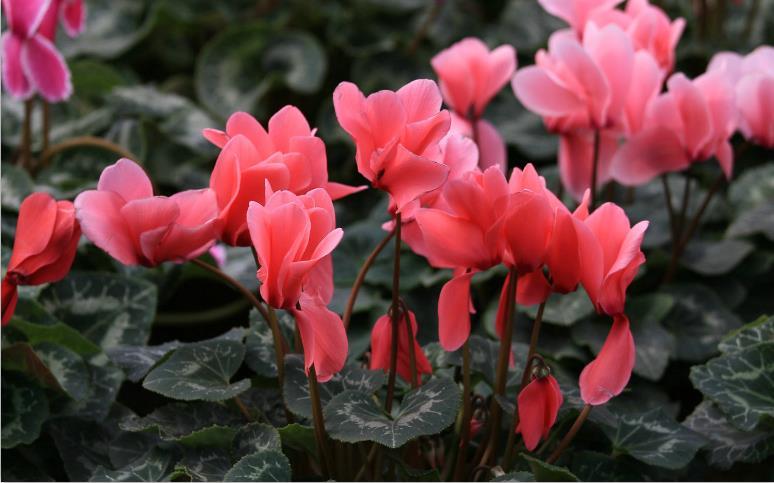
Other common names:Persian cyclamen
Synonyms:Cyclamen latifolium
Family:Primulaceae
Genus:Cyclamen are tuberous perennials with rounded, sometimes angular, leaves which are often attractively mottled. The nodding, characteristically shaped flowers have 5 reflexed and twisted petals, often with dark markings at the base
Details:C. persicum is a winter or spring-flowering tuber, growing to 10-20cm in height. Heart-shaped, dark-green leaves have silver markings. Fragrant white or pink flowers with petals swept upwards have carmine mouths
Plant range:E Mediterranean
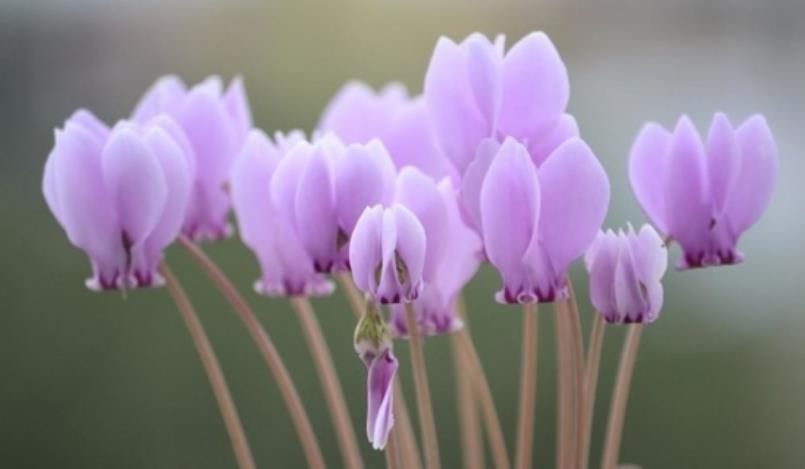
How to grow
Cultivation Grow indoors or under glass in containers of loam-based compost with the tops of the tubers just above the soil surface. Maintain bright, filtered light with moderate humidity and a minimum winter temperature of 5 to 7°C. Avoid draughts and hot dry air. When in growth water moderately and apply a liquid fertiliser fortnightly. Reduce water after flowering and keep dry when dormant

Propagation:Propagate by seed, in darkness as soon as ripe at 12 to 15°C. Can be beneficial to soak seed for 10 hours prior to sowing
Suggested planting locations and garden types:Patio & Container Plants
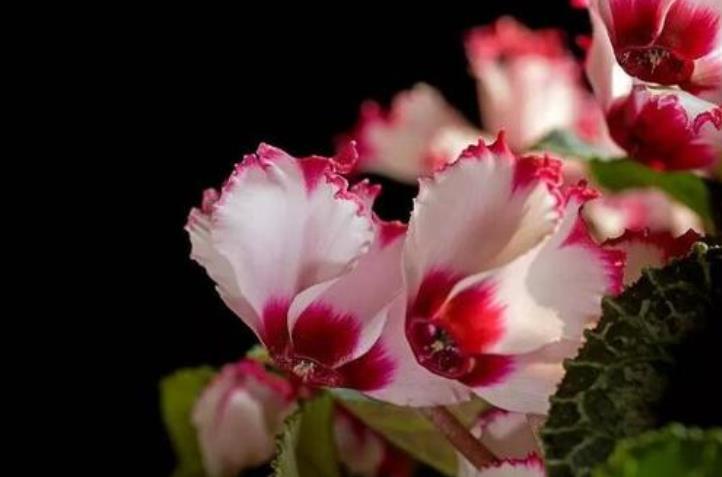
How to care
Pruning No pruning required
Pests May suffer from vine weevils
Diseases May suffer from cyclamen grey mould and black root rot

Other common names:Persian cyclamen
Synonyms:Cyclamen latifolium
Family:Primulaceae
Genus:Cyclamen are tuberous perennials with rounded, sometimes angular, leaves which are often attractively mottled. The nodding, characteristically shaped flowers have 5 reflexed and twisted petals, often with dark markings at the base
Details:C. persicum is a winter or spring-flowering tuber, growing to 10-20cm in height. Heart-shaped, dark-green leaves have silver markings. Fragrant white or pink flowers with petals swept upwards have carmine mouths
Plant range:E Mediterranean

How to grow
Cultivation Grow indoors or under glass in containers of loam-based compost with the tops of the tubers just above the soil surface. Maintain bright, filtered light with moderate humidity and a minimum winter temperature of 5 to 7°C. Avoid draughts and hot dry air. When in growth water moderately and apply a liquid fertiliser fortnightly. Reduce water after flowering and keep dry when dormant

Propagation:Propagate by seed, in darkness as soon as ripe at 12 to 15°C. Can be beneficial to soak seed for 10 hours prior to sowing
Suggested planting locations and garden types:Patio & Container Plants

How to care
Pruning No pruning required
Pests May suffer from vine weevils
Diseases May suffer from cyclamen grey mould and black root rot
1
0
文章
A🎌王木木💮
2019年11月21日

Everything withered in the cold winter,give a feeling of loneliness.If there are still flowers blooming on the balcony,is spring not far from us?Today we are going to introduce the daffodils that are suitable for growing in winter.
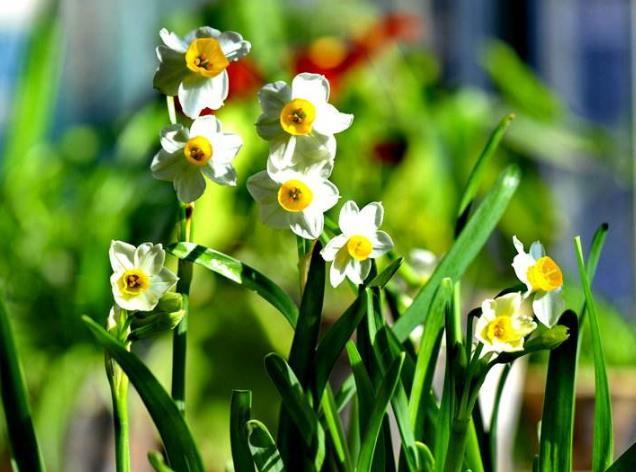
Other common names:daffodil 'Nessa'
Family:Amaryllidaceae
Genus:Narcissus are bulbous herbaceous perennials with linear leaves and leafless stems bearing flowers, which may be solitary or in umbels, with 6 spreading perianth segments and a cup or trumpet-shaped corona
Horticultural Group:Jonquilla and Apodanthus daffodils have very narrow cylindrical leaves and stems with up to 5, usually fragrant, flowers per stem, with spreading perianth segments and a small cup
Details:'Nessa' is a Jonquilla daffodil producing 1-3, strongly scented flowers on each stem in mid-spring. Each 6cm flower comprises yellow, overlapping outer petals surrounding a deeply-ribbed and lightly-frilled, bowl-shaped, orange corona
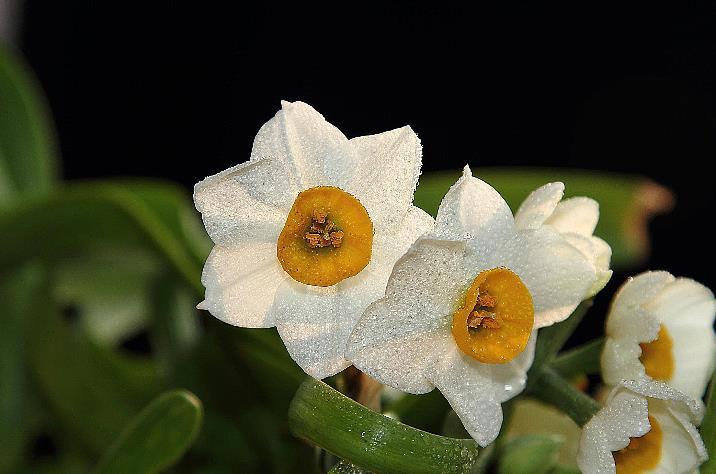
How to grow
Cultivation Plant at one and a half to two times its own depth in autumn. Will tolerate most soils but prefers moderately fertile, well-drained soil that is constantly moist during the growing season. See daffodil cultivation for further advice
Propagation Propagate by removing offsets as the leaves fade in early summer
Suggested planting locations and garden types Flower borders and beds Cut Flowers Low Maintenance City & Courtyard Gardens Cottage & Informal Garden Patio & Container Plants Wildflower meadow

How to care
PruningDeadhead after flowering and allow the leaves to die down naturally
Pests Susceptible to slugs, narcissus bulb fly, narcissus eelworm, and bulb scale mite
Diseases May be affected by narcissus basal rot, narcissus leaf scorch or daffodil viruses

Other common names:daffodil 'Nessa'
Family:Amaryllidaceae
Genus:Narcissus are bulbous herbaceous perennials with linear leaves and leafless stems bearing flowers, which may be solitary or in umbels, with 6 spreading perianth segments and a cup or trumpet-shaped corona
Horticultural Group:Jonquilla and Apodanthus daffodils have very narrow cylindrical leaves and stems with up to 5, usually fragrant, flowers per stem, with spreading perianth segments and a small cup
Details:'Nessa' is a Jonquilla daffodil producing 1-3, strongly scented flowers on each stem in mid-spring. Each 6cm flower comprises yellow, overlapping outer petals surrounding a deeply-ribbed and lightly-frilled, bowl-shaped, orange corona

How to grow
Cultivation Plant at one and a half to two times its own depth in autumn. Will tolerate most soils but prefers moderately fertile, well-drained soil that is constantly moist during the growing season. See daffodil cultivation for further advice
Propagation Propagate by removing offsets as the leaves fade in early summer
Suggested planting locations and garden types Flower borders and beds Cut Flowers Low Maintenance City & Courtyard Gardens Cottage & Informal Garden Patio & Container Plants Wildflower meadow

How to care
PruningDeadhead after flowering and allow the leaves to die down naturally
Pests Susceptible to slugs, narcissus bulb fly, narcissus eelworm, and bulb scale mite
Diseases May be affected by narcissus basal rot, narcissus leaf scorch or daffodil viruses
0
0






